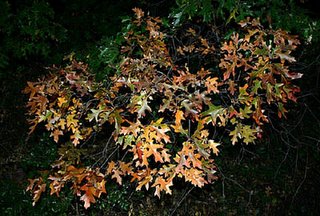(If you’re not a halfway serious user of Photoshop, skip the rest of this post.)
Anyway, I had shot some wild art about a week before Thanksgiving. I was at our community library at about 8 p.m. and saw the young red oaks, just nicely in the process of changing color in our part of the world. One in particular looked photoworthy under the mercury vapor lamps, with poles only about 10 feet high.
So I drove back home to get my camera (tripod was already in my car) and shoot some “natural” light pics (natural as in no strobe).
When I was editing one of them the next day at the office, our photo editor sees me using the Selective Color command. (It’s under Edit à Adjustments.)
He accuses me of “photo manipulation.” Of course, that’s a cardinal sin. He then goes on to say the National Press Photographers Association (of which he may or may not be a paid member — the $99 a year is not a worthwhile investment for me) has ethics (no duh) and that I’m being unethical.
He also had the snarky comment that if you can’t edit it in the camera, you shouldn’t shoot it. (Bullshit, and more on that later, about shooting in the camera.)
We’ll, I’m slow to anger and rare to confrontational expression of anger. So I start cogitating on this for several days. And here’s my answer.
First of all, let me stipulate that I was using Selective Color to fine-tune, and not blow out any colors, saturation, contrast, etc. Now, here’s my response to our photo editor.
First, if you’re just using Levels and Curves, what if you fade them, and use any fade command besides Normal (such as Luminosity) for the fade? That’s manipulating color.
Second, as often needs to be done, what if you dodge an black person’s face. Especially with a newspaper printing on newsprint, not glossy, this has to be done. But, isn’t that manipulation?
Third, as an article in dpreview.com notes, what if I’m deliberately shooting with a Nikon instead of a Canon in certain situations, precisely because of differences between camera brands?
Fourth, different cameras have slightly different white balance settings for the same situation.
Fifth as far as saturation, sharpness and contrast controls in digital cameras, they vary from one to another even on defaults. For example, Canon says about my digital Rebel that the defaults are one setting about Adobe RGB.
Sixth, what if you use fill flash in daytime? True, that’s on the camera, but it’s not what the eye is seeing.
Seventh, what if you’re using filters? Skylight to kill haze? Polarizer for glare? (Lots of it off natural vegetation greens.) A neutral density to blur a waterfall or rapid? A warmer?
 Eighth, and combining Nos. 5-7, I shot some fall color pics in Big Bend. On the north side of a mountain trail, I got some good oak pictures I deliberately underexposed two-thirds of a stop, with a fill flash, shooting at 200 ASA equivalent. The greener leaves in the background of this scrub oak darkened out nicely while the fill flash (via pop-up) brought out the front colors just right. My natural eye certainly didn’t see that.
Eighth, and combining Nos. 5-7, I shot some fall color pics in Big Bend. On the north side of a mountain trail, I got some good oak pictures I deliberately underexposed two-thirds of a stop, with a fill flash, shooting at 200 ASA equivalent. The greener leaves in the background of this scrub oak darkened out nicely while the fill flash (via pop-up) brought out the front colors just right. My natural eye certainly didn’t see that.Ninth, although digital sensors continue to improve on resolution quality in low light, they still don’t compare to the human eye. Even in daylight, pixel numbers don’t equal sensitivity.
Tenth, what if I’m using a generic flash on a name-brand camera? That will skew the camera’s white balance.
Eleventh, Photoshop and another middle or higher-end program, such as Paint Shop Pro, will handle colors differently.
Twelfth, every press is different, and gains color differently. Is adjusting pictures for that “manipulation”?
Thirteenth, what about an Unsharp Mask? What pixel radius and percentage is “acceptable” and what is “manipulation”?
Fourteenth, isn’t trying to draw rules too hard and fast making photography too much science and not enough art?
Fifteenth, photography is holistic. “Shooting” and “editing” are the total and combined act of photography. We edit not just by how we frame pictures, but even with old film cameras, by the use of filters, sun screens, fill flashes, f-stops, shutter speeds and more.
Bottom line — no cutting and pasting, cloning, or other manipulation of artifacts in a “raw” photograph. No unnatural use of colors.
Beyond that, any fine-tuning of colors, done to fine-tune, with the memory of what the picture looked like to the naked eye (if the photographer is also the photo editor) is acceptable in my book.
No comments:
Post a Comment
Your comments are appreciated, as is at least a modicum of politeness.
Comments are moderated, so yours may not appear immediately.
Due to various forms of spamming, comments with professional websites, not your personal website or blog, may be rejected.